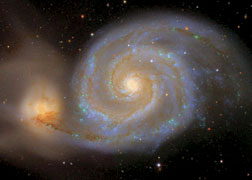 |
|
Image: Sloan Digital Sky Survey |
Sloan Survey shares starry snapshots
In the old days, astronomers who wanted to use a powerful telescope had to buy plane tickets and cross their fingers the weather would cooperate.
“You would apply for time,” says Brian Yanny, a scientist in Fermilab's experimental astrophysics group, “and if you were lucky you would get three to six nights a year.”
Astronomers still use telescopes the old-fashioned way. But today, all you need to access a decade's worth of images and information about the stars is an Internet connection. Fermilab, which handles data for the Sloan Digital Sky Survey, makes that data available through the Web to scientists and armchair astronomers alike.
Sloan surveyed more than a quarter of the sky using an imaging camera—basically a giant digital camera attached to the back of a 2.5-meter telescope in New Mexico. It also measured the distances to the brightest one million galaxies in its field of view.
On the survey's Web site, www.sdss.org, you can comb through images looking for undiscovered comets or new classes of stars, or simply find a cool background image for your computer screen. In a related project called Galaxy Zoo, created by researchers at three universities, volunteers have been classifying millions of galaxies seen in Sloan images.
Making all this data public “just makes a lot of scientific sense,” says Michael Strauss, deputy project scientist for Sloan. “There was far more science than we could do ourselves anyway.”
The Sloan Web site has gotten more than 467 million hits since 2001. In 2008, it has averaged 10 million hits per month, 1.6 million of which are requests for data. More than half of the more than 2000 published papers based on data from the survey were written by researchers not directly involved in it.
Two other projects, the Two Micron All Sky Survey and the UK Infrared Deep Sky Survey, are following the Sloan model by making all their data publicly available.
“One of the things we're proud of at SDSS is that we have been the inspiration for the next generation of projects,” Strauss says. “One of the lessons is: You don't have to keep your cards close to your chest.”
Kathryn Grim
Click here to download the pdf version of this article.






